One of the questions I see on the guitar forums quite a bit is, “What kind of pickups does this Guild guitar have?” Since I’ve posted in many of these threads, I seem to get a lot of emails with the same question. I thought that I might write up a quick summary of the differences as I know them. I originally wrote this article in 2011, and have updated it in 2014.
For Guild AntiHum and LB1 Little Bucker mini-humbucker pickup information, check out my article on them here.
First, let me say that I am by no means the expert on Guild guitars. That honor goes to Hans Moust, author of the excellent book entitled The Guild Guitar Book. Much of what I’ve learned about Guild pickups, I attribute to Hans helping me via email and through forum posts. If you’d like to learn more about Guild guitars, I heartily recommend that you pick up a copy of his book.
To the best of my knowledge, there are two types of Guild HB1 pickups – the mini humbuckers (affectionately called “mini-hums”), and the full-sized humbuckers. This article focuses on the full-sized pickups, which, for reasons that should soon be clear, are often confused. We’ll be looking at three different pickups, all of which look very similar from a distance, and some of which look identical from the front. I’m not entirely sure of the correct names, but for the sake of this article, I will call them Guild HB1s, Seymour Duncan SD1s, and Fender HB1s. There are some others in there as well. Read on to learn more.
Guild HB1
First, let’s take a look at the original full-sized HB1. This is the pickup that Guild guys lust for, because though they don’t quite sound like anything else, they sound amazingly good. I’ve not played an original Gibson PAF pickup since the 70s, but I’ve heard the Guild HB1 compared to that iconic pickup. I’ve seen these pickups on Guild guitars from the ’70s, ’80s, and early ’90s.
These pickups define what a full-sized HB1s look like. There are two raised areas on the pickup, one containing the pole pieces, and the other blank. The later SD1 and Fender HB1 pickups look the same at quick glance, but as we’ll see, there are important differences. I call this the “double hump” cover.
Vintage Guid HB1 pickups are the same length as “regular” Gibson-style humbuckers, but they are wider so they don’t easily fit into other guitars. In the original article, I had written that HB1s are longer and wider than regular humbuckers, but that is incorrect. I discovered this by trying a very simple test; I tried to mash an HB1 into a Gibson ring. As you can see in the picture to the right, the HB1 fits lengthwise, but the width is too great for the ring. The odd size of the HB1 pickups causes the following problems:
- Guild Hb1s don’t fit in many other guitars (including later Guilds)
- Regular pickup covers don’t fit on the HB1s
- Regular pickup rings don’t work with the HB1s
Just how much of a difference are we talking about here? I whipped out the calipers and measured every pickup combination I could get my hands on. The diagram to the right reflects the measurements of Guild HB1s (red) and regular humbuckers (yellow). Both pickups are 2 ¾ inches in length, but the Guild HB1 is 1 9/16″ wide where the regular humbucker is 1 ½” wide. That’s only a difference of 1.59mm, but it’s enough to cause problems.
Note that the Guild and Fender pickups look almost identical from the top. The main trick, observing from the outside, is to look at the mounting screws. On the vintage HB1s, these screws are farther apart than they are on Fender HB1s. In fact, just from looking at the front of the guitar, provided everything is stock, this is the first thing to check. Unfortunately, it’s not a guarantee that the pickups are vintage HB1s, as we’ll see in a bit. Still, wide adjustment screws are a good indication of what you might find when you pull the pickups.
The only way to tell for sure if the pickups in question are vintage Guild HB1s is to pull them from the guitar. They don’t have to be unsoldered, but you’ll need to pop them out to look at the back. I’ve included a few examples of vintage Guild HB1s for references, and you should be able to see the similarities in them all.
First, most all Guild HB1s will have “Guild Made in USA” engraved into the base of the pickup. Many of the vintage samples will also have a date, which may look like it was scratched in by hand, or with a rotary engraving tool. If you see this, then you’re in luck, because unless someone went to great lengths to make a fake (which I’ve never seen), then you’ve got yourself a vintage HB1. The date will likely confirm that the pickups are from the ’70s or ’80s. Not all vintage HB1s have this date, and I’ve seen some where the date was so faint that at first glance that I thought it wasn’t there.
Another thing to look for is the presence of solder terminals. Vintage Guild HB1s have solder terminals on them, so that if you need to replace the pickup from your guitar, you don’t have to pull the wiring. Not only that, but there is no risk of cutting the lead wires too short, or pulling them out by accident. Personally, I think this is about the most brilliant thing I’ve ever seen, and I have no idea why all pickups aren’t made this way. The solder terminal will appear on one side of the pickup, and will look like a little circuit board sitting up, perpendicular to the base.
Zoom into the pictures of the two Guild HB1s and look at the solder terminals. Notice how they look different on the two pickups? One has closer terminals, and one has them spaced farther apart. The pickup with the wider-spaced terminals is the bridge pickup. The terminals are wider to allow the addition of an additional ground wire that runs to a toggle switch. This switch allows the pickup to be thrown out of phase with the other pickup, a feature included on many of the 70s era Guild electric guitars. Regardless of whether or not the guitar had a phase switch, the pickup with the wider terminals should be the bridge pickup, since it will generally measure a little hotter than the other one in the pair.
By the way, these two pickups have red spots on the base plates. I have no idea what this represents, but I’ve seen it many times. If you know what it is and can back it up with proof, I’ll buy you lunch. Personally, I think it means that the pickups were returned, repaired, or opened by Guild for some reason, but I have no proof of that other than thinking that every one I’ve seen looks to have a re-worked solder joint where the base plate meets the cover. I have a feeling that I may be buying Hans lunch when his next book comes out.
In a nutshell, if the pickups look like the ones I’ve shown in this section, then they are vintage HB1s. Naturally, there is an exception to the rule. Until recently, I never knew this, but again, Hans set me straight when I bought a guitar and went online telling the world that it didn’t have HB1s.
4-Wire HB1s
This pickup came to me in a 1994 Guild Starfire. These pickups look just like the Seymour Duncan SD1s that we’ll talk about in a bit, but as soon as I showed a pic of them to Hans he told me that they were HB1s. Sure enough, when I measured them with a caliper, they measured as the wider and longer HB1s. This was a serious score for me, because this was a guitar with a modern neck profile, an ebony fretboard, and vintage-sounding HB1s – a rare combination in a Guild Starfire guitar.
Over the years I’ve scored a few more of these rare mid-90s Guild HB1s, so they’re obviously out there, though they can be very hard to find. I’ve not taken these pickups apart so I can’t say if they’re internally different than the Seymour Duncan SD1s shown below, but I can say that the 1994 Guild HB1s with the 4-wire setup may be my favorite pickup of all time. In fact, I now own two sets of these that are New Old Stock purchased through Hans Moust, both of which have been installed into Guild Nightbirds (one is shown to the right). And yes, I paid a lot of money for the privilege which was totally worth it to me.
Hex Pole-Piece HB1s
Another rare variation of the HB1 is the one shown here that has hex pole-pieces. I’ve only ever seen these in one finished guitar, and that’s the beautiful and über-rare Guild S200 owned by Kurt over at The Guilds of Grot. Interestingly enough, I recently (2021) got an email from Ken Nash over on The Guitar Mechanic who had picked up an S50 pick guard with one of these pickups installed. His was a chrome example, so they have been made in both chrome and gold.
The backs of these pickups look like any other vintage Guild HB1 and the two that I have are both stamped Made in USA and Guild. Like the other HB1s, they have solder terminals and the bridge example have three while the neck pickups have two.
Note that these pickups measure a whopping 16K DC resistance, so they’re a fair bit hotter than the traditional HB1s.
Seymour Duncans with Guild Covers
I’m not sure if there’s a precise Guild-esque name for these cool examples, but I’ve been watching for Guild pickups on eBay, Reverb, and such for years and this is the first pair I’ve ever encountered. This pair is from a 1994 S100 serial number FB000019 which was torn apart for parts by a known vintage guitar chop-shop on eBay. I try not to buy from sellers that do such things, but they got me with these because I wanted ’em bad. As you can see by the first pic, they look just like the Seymour Duncan SD1s shown below and have the same tell-tale small black Phillips-head adjustment screws, but these are not SD1s.
I’d read some time ago that before Seymour Duncan (SD) started making the SD1s, that they literally stuffed their own pickups into Guild covers. That’s what these are. The bridge pickup is an SD JB. The last J in the JBJ sticker is a reference to the winder, who according to this link was Maricela Juarez before she joined Seymour himself in the custom shop. This is a 4-wire pickup with typical SD coloring and with the white and red wires twisted together. This pickup would have been in the bridge where the 4-wire configuration would have been used for the Guild phase switch.
The other pickup is a SD ’59 Neck pickup wound by the same person I believe, since as best I can tell that is also a J at the end of the very faded label (another reference here). This is a traditionally wired pickup with a length of braided single-conductor lead. Note that both pickups have 2-to-1 adapters that let the single adjustment screw leg work with the Guild rings.
The covers are the same size as Guild HB1s and SD SD1s, but as you can see there is a small gap around the base-plate because the pickup itself wasn’t designed for this cover. What’s fascinating to me about these pickups is that the Guild S100 guitar would later have regular SD JB and ’59 pickups installed without the iconic double-hump covers (not SD1s – actual SD ’59 and JB pickups). For me, nothing screams Guild like those covers, though, so these are a pretty cool find.
On a last note, I have owned the Guild S100 with the serial number FB000005 (one of the first reissues made) which had 4-wire Guild HB1s. These came from S/N FB000019 which is only 14 guitars away from the same year and they were already moving to SD making their pickups. That seems to indicate that a 1994 with real Guild HB1s is a pretty rare beast.
Seymour Duncan SD1
In the mid to late nineties, Fender (FMIC) bought Guild and contracted Seymour Duncan to make pickups for Guild guitars.
My experience with SD1s came in the form of a beautiful Mahogany Guild Starfire III from 1997 that sounded amazing. It sounded so good, in fact, that I was honestly floored when I pulled the pickups and found them not to be Guild HB1s. If you’ve got a Guild with these pickups in it, don’t touch a thing. Though the purists may prefer the vintage HB1s, these pickups sound so good that there is no reason to pull them short of a mechanical or electrical failure.
Evan Skopp from Seymour Duncan had this to say about Seymour Duncan’s involvement with Guild pickups during the FMIC era:
When FMIC purchased Guild, we made their humbucker pickups for the first year or so while they were tooling up… What we wound under the covers to capture as much of the original sound as possible, was very close to our SH-1 ’59 Model. Ironically, when FMIC eventually took over production of this pickup, they called it the “SD-1” and everyone thought we were still making them — but we weren’t.
and…
When Seymour Duncan did the SD-1, they were basically ’59s. They used an Alnico 5 magnet and a very similar winding spec to the ’59. The biggest difference was the bobbin material. We used a plastic with a different shrink rate than the polycarbonate we used on Seymour Duncan pickups so we could make the bobbins fit with the Guild-supplied covers and bottom plates.
Source: Seymour Duncan Forum
From the front, these pickups look just like Guild HB1s, and they have the wider adjustment screws like the vintage HB1s. From the back, they have the Guild Made in USA imprint, but they do not have the solder terminals. Instead, tiny insulated wires protrude from the case where they are soldered under heat shrink to the cable that runs to the pots. The grounds will be soldered to the back of the pickup. You may see them with very short leads (above) or regular-length leads (below).
In the SD1s that I’ve seen, the neck pickup had a sticker with the label “NL”, while the bridge pickup has a similar sticker labeled, “BL”. As you can see in the comments, some people have reported other labels as well, including “NP” and “NB”. Though I have not personally witnessed these labels, I have no reason to doubt the veracity of the claims. Regardless of that the stickers might say, I would not judge the authenticity of the pickup from a label that is easily removed or replaced, but rather on the overall look of the pickup. Still, it’s probably a good sign if you see these labels.
I would describe these pickups as looking like “HB1s without the solder terminals”. Indeed, according to the quote above, the covers and back plates were provided by Guild, so these pickups have the same dimensions and overall look as the Guild HB1s. Note that since they are the same size as the Guild HB1, they will not fit into traditional pickup rings or routes.
This brings up the question, how do we tell them apart without taking the guitar apart? Well, I think I’ve found a way. This has not been proven, but it seems to bear out the critical application of judicious observation. If I’m right, the answer is in the adjustment screws.
Guild HB1 pickups come with large, flat-head silver or gold adjustment screws, while every SD1-equippened guitar I’ve seen has come with smaller, black or gold phillips-head adjustment screws similar to those found on the Fender HB1s. The thing about the SD1s is that the adjustment screws are father apart like they are on HB1s. See the pickups from the red 1994 Starfire IV to the right? ? Those are very late-model Guild HB1s, and look at the adjustment screws with those large flat-heads. The covers and the adjustment screws look the same on HB1s from the 1970s, though the backs look very different.
Contrast those with the picture of the mahogany Starfire III from 1998, and again look at the double adjustment screws. They’re still far apart like they are on an HB1, but the screws are smaller phillips-heads.
What about later Guilds that have the wide adjustment screws but don’t have the “double hump” covers? Those aren’t SD1s, but rather regular old Seymour Duncan JB and ’59 pickups, and aren’t the same physical dimensions as the SD1s and HB1s.
Fender HB1
At some point in the late 1990s or early 2000s, Fender decided that they could make the pickups better, faster or (most likely) cheaper than Seymour Duncan was, so they started making their own model that looked like an HB1, at least from the front.
I’m not a fan of these pickups, as I find then uninspiring and lifeless, especially when compared against any of the other pickups listed on this page. Still, many people like them, and they do their job while looking great. I must add that since I originally wrote this article, I have purchased a rare Guild Nightbird that has these pickups in it, and it sounds fantastic, but with a caveat. This Nightbird has a coil-split switch which removes the second coil from the humbucker, essentially making it a single coil pickup. With the Fender HB1 pickups split in my Nightbird, it sounds amazing. I can even get close to that Strat position 2/4 sound in the middle position. Unfortunately, the pickups get muddy and lifeless again as soon as I put them back into humbucker mode. They have since been replaced with 4-wire Guild HB1s.
From the front, these pickups look just like the original HB1s. The teltale sign that they’re not is the space between the pickup adjustment screws. Notice how they’re a bit closer together than the adjustment screws on the Guild HB1 pictured above? That’s a pretty good clue that these are Fenders. In fact, the guys on the Guild forum (myself included) will see these screws and know right away that the guitar is a Fender-era reissue, assuming everything is original.
Of course a better test is to pull the pickups and look at the back. Fender HB1 backs have a distinctive look to them that is easy to recognize on sight. The best way to describe this look is, “a mess”. As you can see, there is some variation, though, and not all of them are quite so messy.
I should add that the “mess” of wires appears to just be the inter-coil connections which are usually inside the cover, so this “mess” of wires may offer some additional wiring possibilities such as those found in my Nightbird. If you’d like to learn more, check out my article on Guild Pickup Wiring.
Notice that from the back there is the distinctive wiring pattern and three threads on each side for pickup adjustment screws. This is another dead giveaway that these are Fender HB1s since vintage HB1s and even SD1s have only two holes on one side and one on the other. Though they still have “Guild” stamped on the back, that and the double bump covers are about all they have in common with vintage HB1s.
I should point out again that the screw spacing trick is not fool-proof. My Nightbird looked from the front as if it might have Guild HB1s or SD1s in it based on the adjustment screws. I was very excited when I bought it because I’d never seen a Nightbird with HB1s. When I pulled the pickups, I was surprised to see Fender HB1 pickups with an adapter. This method of mounting standard pickups into a Guild HB1 pickup ring was used by Guild and you can see it in the Seymour Duncans in Guild covers above. I’ve seen the same sort of thing in a Dimarzio-equipped Guild S300A-D.
One of the benefits of the Fender HB1 pickups is that they are the same size as regular humbucker pickups, so they will fit in other guitars if for some odd reason you wanted to use them elsewhere. The real benefit is that they can easily be replaced. I like the looks of the covers though, so I’ve gone so far as to have a set rewound by a respected boutique pickup winder. He made me promise not to say who he was because he hates doing rewinding work. Sorry. He did tell me that he had to use the original bobbins because his “standard” bobbins would not fit in the Fender HB1 covers. Given the fact that the outer dimensions are the same, I found that interesting.
I get asked this a lot, so let me say catagorically that vintage HB1s will not fit into Fender HB1 routes. Any other humbucker pickup designed to standard Gibson specs will fit, but the Vintage HB1s will not. You can, however, use regular pickup rings with Fender HB1s due to the three adjustment screws on each leg.
There a couple of exceptions to this rule – the Guild Bluesbird being one of them. For some reason, Guild Bluesbirds, up until the end of their production in Fender’s hands, were routed with vintage specs, so there’s a great chance that a Fender Guild Bluesbird will take vintage HB1s. In my experience, with my 1974 HB1s and a factory second Bluesbird, they almost fit. You can see how close they were in the picture to the right. You can also see the wide spacing routed to allow the wider legs on the vintage Guild pickups.
In this guitar, the difference was about a millimeter at the corners. I have to wonder if this was the reason for the guitar being a second, because it seemed perfect in every other way. After manually filing out the corners, the pickups slipped in and worked like a charm. One one of my other Bluesbirds, this slight alteration was not needed and the pickup slid right in, though care should be taken as the HB1 rings do not fit between the pickup and the neck binding on these guitars.
I had to get vintage Guild HB1 rings, since the Fender rings had the adjustment screw holes in the wrong place. The neck pickup ring was also very tight against the neck, to the point that I had to file it down, but it can be done. Note that the pickup ring mounting holes may not line up when converting to HB1s. In fact, let’s take a look at the differences in pickup rings.
Newark Street HB1s
At first I hesitated to include these because they’re not vintage, but they look so much like vintage HB1s that I felt the need to do so. The picture to the right is of a 2016 Guild Newark Street (NS) HB1 pickup, and yes, it looks just like the real thing. It even measures the same. That’s good and it’s bad, because it means that you can probably put a vintage HB1 into a Newark Street Guild (yay!) and it means that unscrupulous people might put a NS HB1 into a vintage Guild (boo!) I’ve not seen that happen yet, but I feel that it’s only a matter of time. Even the adjustment screws are similar (though technically a bit more rounded where the older ones are flatter).
The only way to be sure is to pull the pickup, because the back is quite obviously different than the vintage variety. The Newark Street HB1 has a very different solder board, and includes modern labels and an RoHS sticker. Technically, the NS HB1 pickups are slightly different in size, but you’d only notice this if you had them out of a guitar and examined them side by side. The difference is that the legs on the vintage HB1s are longer than the NS model.
Pickup Ring Dimensions
I know of three different pickup ring configurations for these pickups. I had examples of all three, so I pulled out my calipers and measured them all.
Guild HB1 Rings
First, the original Guild Vintage HB1 pickup rings. Naturally, they are designed to fit the vintage Guild HB1s, so the main hole is wider, and there are two adjustment screws on one side spaced ¾ of an inch apart. These rings tend to be a bit thicker on the sides and have a generally beefier feel to them from most modern pickup rings. Note that the outer dimensions of these rings is larger in both dimensions than the Fender or regular humbucker rings. These rings are pretty hard to find, and as of 2014, I see them selling for $75 or more for a pair on Ebay. Having a set of vintage HB1s without also having the rings can be a problem since the HB1s won’t fit in any other rings that I’m aware of.
The ring dimensions are the same for Guild SD1 pickups as well as the Newark Street HB1 pickups.
Fender HB1 Rings
The Fender-era Guild HB1 pickup rings have the same overall dimensions as a regular Gibson humbucker, with the addition of the dual adjustment holes on one side. These holes are spaced ½ inch apart. Note the smaller overall dimensions on these rings compared to the Guild HB1 rings. More importantly, notice that the mounting screw spacing is different. Again, these Fender HB1 rings are more closely matched to regular Gibson-style rings with the addition of the dual adjustment screws.
Regular Gibson-Style Rings
What I call regular Gibson-style rings are the rings you’re likely to get if you walked into any music store today and asked for “humbucker pickup rings”. Note that the overall dimensions are the same as the Fender HB1 rings, as are the mounting screw positions. Really, the only difference that I can see between Fender HB1 rings and regular rings is the difference in adjustment screw holes. Since the Fender HB1 pickups have three holes on each leg, they will work in regular rings.
Conclusion
So there you have it: everything I know about Guild full-sized HB1 pickups. I hope it helps in your quest for Guild guitar bliss. If you’re lucky enough to have a Guild with vintage HB1s, or even those great-sounding SD1s, I’d love to hear about it! Consider joining the Let’s Talk Guild forum at https://letstalkguild.com/ where we can all drool over your guitar. That’s where I learned most of what I’ve written here, so imagine what else you might learn. There are a lot of people who really love Guilds over there.
Heck, I like Guilds so much that even a Fender-laden Guild is a good Guild. I own two myself, because regardless of the pickups, nothing beats a Guild.
Be sure to check out my other Guild Guitar articles at gadsguilds.com!

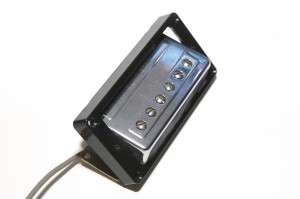

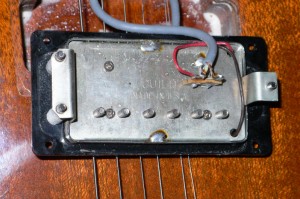
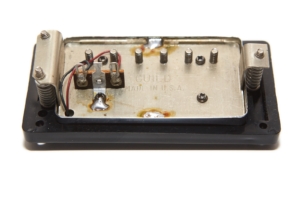
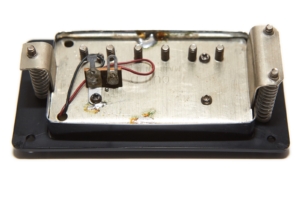
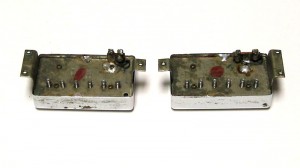
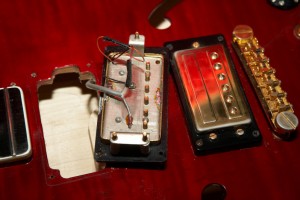
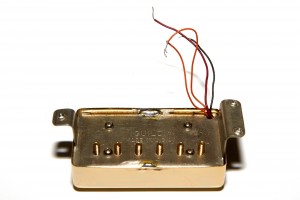
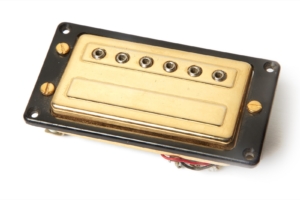
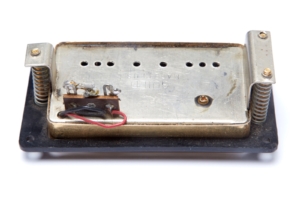
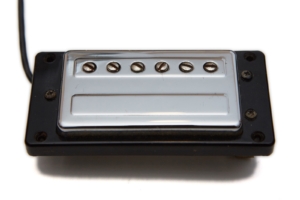
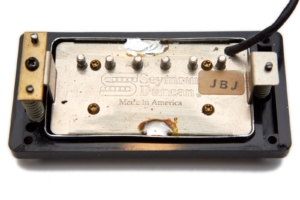
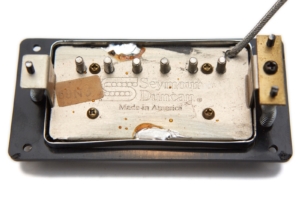
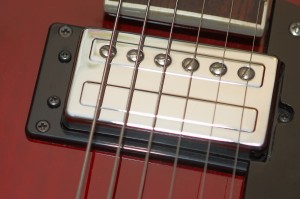
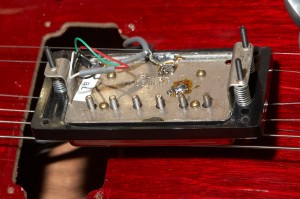
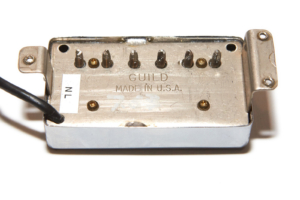
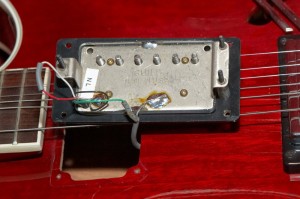
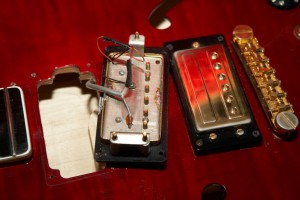

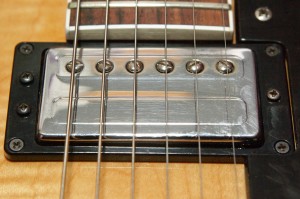
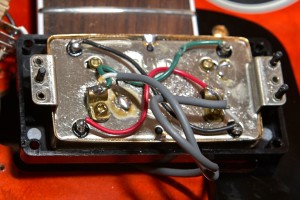
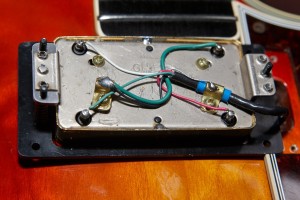
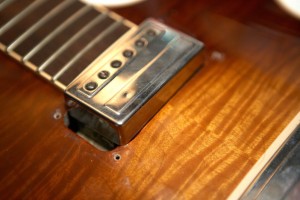
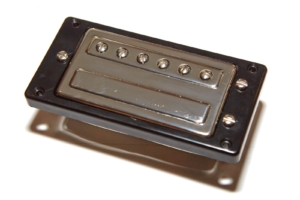
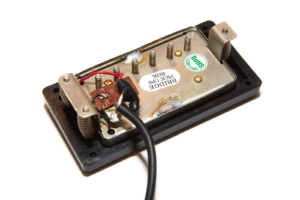
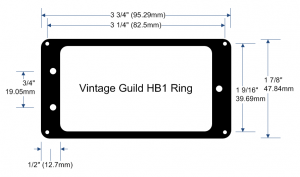
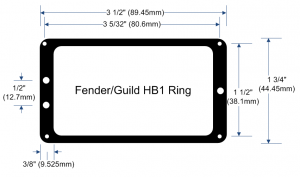
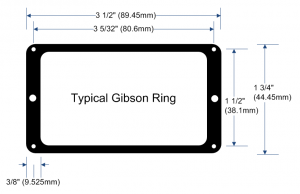
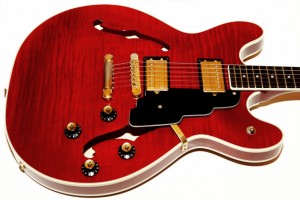

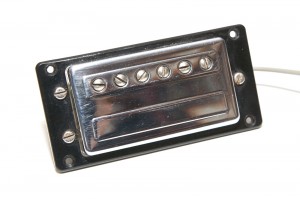
Excellent job !!! I was given some HB”s for a Guild project. Now I know one is Fender and one is Duncan. The Fender was missing wires, I can now wire the mess.
Thanks for all the info. and I agree nothing beats a Guild . ( I own three ) Phil
hello…I have a guild starfire from 1967…i believe these early HB1’s are a tad narrower than those from the 70’s…They are lovely in many ways but the bridge pup in particular is a bit thin and I am thinking about changing if possible with no cosmetic issues…do you know if you can put a gibson or SD humbucker in it’s place?
thanks
james
Those are colloquially known as “mini hums”. I don’t’ have exact measurements, but I’m pretty sure that a standard hum-bucker will not fit in those holes without routing out the body. You can keep an eye out on Ebay for Guild pickups that match yours, but be warned – they fetch a pretty penny.
Just an update that I’ve posted an entire article on the ’60s Guild AntiHum mini-humbucker pickups: https://www.gad.net/Blog/2018/03/09/guild-anti-hum-lb1-mini-humbucker-pickups/
I’m a bit confused. Are the SD1’s the same size as the HB1’s? Your diagram indicates that they are smaller. If Guild had Seymour Duncan “produce them, or at least stuff them into HB1 covers” I assume they were the same size as HD1s. I have a chrome HD1 (or SD1) with red,white,green and black leads, grounds soldered to the back with true HD1 dimensions. Can I assume it’s a 90’s era SD1?.
Add to the above description a label that says NB. I can send you a picture if you’d like.
Sorry Gary, that label is stamped “NP” (for neck pickup I imagine.)
Just popped out the neck pickup of my 97 starfire 4, it has the label NP as well.
I have a Starfire III with the Fender pickups and while I love the playability of the guitar I’ve felt for a while the tone to be lacking somewhat. I’m curious who rewound your pickups for you. Where you happy with the results? We’re they wound to HB1 specs? I’d be very interested in persuing this for my guitar.
Thanks,
Curt Florczak
I’m looking for a replacement bridge pickup for a mid 60’s Guild CE 100 BL. Any suggestions?
Thanks!
Hello, I have a SF 4 out of 1976. The size of the pickups is also slightly less then the HB-1’s as described above. THey are exactly in the middle with 39.1 millimiters. However the ring is 39.6625. Is the conclusion then correct that this is the mini hum?
I have a ’67 Starfire VI which I’ve owned since about ’73. Interesting how you say these pups are sought after today and will fetch a pretty penny. One of the first things I did after owning the guitar for about a year was yank those things out! They were “unique”, I’ll grant you that, but I hated them because they had a tinny almost gravelly sound – note I didn’t say “growl-like”. They didn’t clean up at all, and they didn’t sound great with distortion either. Just very unpleasant. I loved everything else about the guitar, the weight, neck, position of the controls, bigsby, etc. Played like butter! Anyway, these were original ’67 pups and I replaced them with Gibson Pat # pups of ’73 or earlier vintage which suited the guitar perfectly, and still do! These are crystal clear clean, and have a rich tone when a bit of dirt is applied or run through tubes. But here’s the point: the Guild HB’s were narrower, not wider, than the Gibsons, such that I had to expand the pickup cavities to accommodate them. As for the HB1’s, I simply gave the old pups to a friend who put them in a Goya hollow body. Sure wish I’d saved em! (Only for resale, since I still remember that scratchy sound they made. ) I’m extremely happy with my now classic ‘T-top’ humbuckers.
Thanks for the comment.
A 1967 Starfire would have had “mini-hums”, not the full-size HB1s that are the subject of this article. Minihums are smaller than “normal” pickups, and do have a different tone than the larger HB1s.
It is actually a nice and helpful piece of information. I
am glad that you shared this useful info with us. Please keep us up
to date like this. Thank you for sharing.
Hey, phenomenal write-up… I’ve seen this page referenced all over the Internet. Thank you for taking the time to piece together all of this info!
I have a question about the pickups in my ’96 SF4 for you, see the photos below. The stickers on these scream SD1s… but they undersides don’t seem to match any picture I see on this site. The closest thing I see is the HB1s that came out of your ’94. What do you think, SD1 or HB1? (fyi – even though it’s not pictured, there is wider spacing on the adjustment screws, so it’s gotta be one or the other)
https://www.dropbox.com/s/82rjgp327u3ern3/Photo%20Jan%2031%2C%2011%2016%2026%20PM.jpg?dl=0
https://www.dropbox.com/s/tuy31ml41uy44nu/Photo%20Jan%2031%2C%2011%2010%2055%20PM.jpg?dl=0
Thanks for the kind words!
Those are definitely SD1s. If you look at my pics of SD1s, you’ll see that they have the same black cable coming out – it’s just that the insulation is cut way back almost to the pickup back plate on mine revealing the four inner wires. If they were Guild HB1s, there would be four wires straight out of the pickup: red, black, and two orange. My guess is that your wires are red, white, black and green, further proving that they’re SD pickups.
FWIW I’ve only ever seen those late-model Guild HB1s in guitars from 1994. That’s not empirical data by any stretch, but I would be surprised to see them in anything after ’94.
Don’t let that bother you, though. I really like the SD1s. They don’t quite have the high-end sparkle like the HB1s IMO, but they’re WAY better than the Fender HB1s that came later. If you really want HB1s for some reason (and I totally get that), then they will drop right into the routes since SD1s are the same size. Good luck finding a pair, though, especially those ’94 versions. They’re rare and can cost a pretty penny.
HTH!
GAD
Thanks again Gary… good to see another fellow network-guy in the guitar world – it must be in our DNA!
I’m restoring and upgrading my vintage Jetstar s-50 and considering refinishing the body, replacing the original bridge pickup and tuners. The bride has been replace and I’ll keep the original parts. Any suggestions on a pickup for this model?
Hey there,
I love this blog on the S-100, I have a 1996 version.
I have been loocking for an accurate version of the wiring diagram for this with the phase switch and SD pickups, but can’t seem to find it anywhere on google… is it at all posible that you might have a pic, pdf or link to it that you could either post or send me please?
ps, keep up the good work
Regards
Gus
Hey there! I wrote up a 1997 S100 including a control cavity pic here: https://www.gad.net/Blog/2016/08/12/1997-guild-s-100-guitar/
I just added the wiring diagram to the review. I hope it helps you out!
BTW the S100 probably came with SH1 pickups vs SD1s. The SD1s have the double humps while the SH1 looks like a regular pickup, albeit with the 3×1 adjustment screws found on Guild electrics.
I had a Guild Starfire that was sold to me as a 1965 with stereo pick ups. Long story short, a trusted friend borrowed it and gave it to a well known Luthier here in Los Angeles for money he owed him. I never saw the guitar again, but I had forgotten that I swapped out the Pups before it went missing. I recently found the Pups I pulled out of it. They are phased and have 1974 etched on the back. Are they worth much?
Depending on condition and if they have the rings they can be worth north of $300 for the set.
Gary…I was fortunate to buy a 2002 Guild Bluesbird with the flamed maple top in a pawn shop. From your article here and checking the dimensions, I think mine has the Fender HB1 pickups in it. What is strange is that Fender’s spec sheet says that the pups are Seymour Duncan SD-1. Maybe this a marketing ploy?? Anyway, if they are truly Fender made I’m thinking of changing them for SD ‘59s or SD Seth Lover set for a better sound. What might be your take on this?
Tom
Bluesbirds in the late ’90s and early ’00s came with Seymour Duncan pickups from the factory. They have normal covers – not the double-hump covers seen on other Guilds. The SD1s from the late-90s Starfires look different since they have the double-hump covers. If you have double-hump covers in your guitar then they’re possibly not original. If they look like “normal” humbuckers (flat metal cover) then there’s a good chance they’re original SDs. The best way to tell for sure is to send me a pic of the front and back of the pickup. I may be able to tell from just the front depending on what’s there.
Hi,
Great article. I make reproduction HB-1 rings for ’70s-’80s guitars and just discovered from a customer that 1970-1973 models have rings with the same internal dimensions but with external dimensions that are narrower side to side. The later rings have the holes for the height adjustment screws closer to the pickup than the edge of the ring. The 1970-1973 rings have the adjustment holes equidistant between the pickup and ring edge. So the later rings will interfere with pickguards on the 70-73 models.
Thanks
That’s some great info – thanks!
I have a guild S100 Newark Street. I’d like the coil tap and do a reverse polarity for the humbucker mid position. Is there any place I can find that will show me how to accomplish this? Thanks
You don’t say if they’re HB1s or LB1s, but Newark Street pickups are 2-wire and thus cannot be split without dismantling the pickup.
Phase (polarity is a magnetic thing), on the other hand, is simply a matter of changing the wires with a mini-toggle or push/pull. That is done like this: https://www.premierguitar.com/articles/21006-mod-garage-adding-an-out-of-phase-switch-to-a-telecaster. Though it shows a telecaster, the wiring is the same. Just do it on one of the pickups (usually the bridge on a Guild).
Gary,
I am looking at a 1979 Starfire 4-D with DiMarzio pickups as standard issue. Do you have any experience with these or an opinion, as they are much more rare.
BTW – Love your site!!!
Mitch
Thanks! They’re the same guitars – just with different pickups. The coils can look a little sparse because the rings are for HB1s (same problem on S300ADs) but if you like the hotter/darker sound of the Dimarzios over the HB1s, then it’s a great choice. If you’re looking at this one on Reverb, those are HB1s and not Dimarzios. I’m also not convinced that the mini-toggle is original. If it’s not that guitar then never mind. 🙂
Hi, and thanks for providing this excellent info.
I’m the lucky owner of a 1975 M75 Bluesbird and a 1972 Starfire ll and I consider the original HB1 the finest production HB ever made.
I know the purists will cringe, but I had a friend with a mid 70s Starfire who put a coil split on one (neck pu), and that was probably the best SC I’ve heard!
As I’m a humbucker fan my 2 gats are safe, but it really was nice. The closest thing I’ve heard was a original late 50s strat. Low output, but “chimey” and smooth at the same time.
Hi Gary, thanks so much for this information. In a 1997 X-170, if the black philips pickup adjustment screws are wide-set and the pickup cover width is the wider Guild HB1 cover, is it reasonable to say it’s probably an SD1 and that it shouldn’t be a Fender HB1? Or is it possible that Fender stuffed Fender HB1’s into Guild covers for some models? Thanks!
I have been “tricked” once or twice by the screws being connected to an adapter, but that was on a 2001 model. If the pickups are factory, there’s no way a 1997 Guild has Fender pickups in it.
hello… can you help? I am restoring a guild s 100 with transparent pickguard. I cannot find tuners and one pickup ring (bridge). any hint? Guitar is beat up and cracked and repaired.. have a set of round 6×6 grover looking guild branded tuners but won’t fit (one hole)
cheers
Enrico
bologna italy
Try Hans at his website.
The S100 Ian Hunter played sounded very good as a rhythm instrument complimenting either Mick Ralphs or Ariel Bender (Luther Grosvenor) So maybe it is a guitar that was overlooked in its time? He claimed he played them as they had a great warranty.
GAD,
I am waiting on a Guild Savoy X-150D from Reverb. It was advertised as a 1996 but when I look at the picture of the front of the pickup I see the small phillips head black screws close together indicating that they are Fender HB1’s.
What are your thoughts?
If it’s the sunburst one I see recently sold, then it’s probably from ~2000 and the Fender HB1s would be correct. The ad does say “The serial number dates back to 1997-99 and is probably from later in that timeline.” and that’s because the official serial number charts from Guild only go up to 1997.
GAD,
I apologize for the misinformation I sent on the Guild, I got ahead of myself.
The Guitar was advertised as a 1997 Guild Savoy X-150D made in Westerly RI serial # AK150296..
I wrote to Hans Moust and he replied with a 1999 date. Still making it stocked with Fender HB1’s..
Thank you for answering my messages..
Nick C
GAD,
I have an Emerald 1963 Guild Starfire 111. I was interested in your Pickup analysis but the one thing I noticed on my pickups was, I only have 2 mounting holes/screws similar to the Gibson Style Ring, not 3 as shown in every one of your examples. So……….what happened there in 1963. I am the original owner so there has not been any substitution of hardware etc. Do I have some hybrid variant of HB 1. The plot thickens
CS
If you have a 1963 SFIII with Guild pickups that look like smaller HB1s, then they’re Guild AntiHums and not HB1s. Check out this link: https://www.gad.net/Blog/2018/03/09/guild-anti-hum-lb1-mini-humbucker-pickups/
Right On GAD – youda man. That’s them. Thanks
Hi Gad, Further to your previous email and further reading of you Antihum blog, I took a look at my pickups and can confirm that the Neck pup is like the one you show in your photo with “no hole” but I don’t have the word GUILD stamped on it, however, it does have what appears to be an inspector stamp – a purple circle about 3/8″ dia – with faded letters – could be 0C2, BC2,or 8C2 inside the circle. Hmm.
The Bridge pup again is like your picture with “the hole” and no ident markings whatsoever. I noted that the base plates are not a goldy color as in you photos but a dull grey.
Hope this helps.
CS
Good evening
I am sure you can help me with a simple question.
Guild XR-7 pickups made by Dimarzio are good enough to play jazz in a1986 SF4.
Unfortunately, i can not check the guitar.
Thank you very much for your advice
Warm regards.
I don’t see why not. Though I don’t have any examples in a Starfire, you can hear samples of XR7s in the Sound section of the following reviews:
https://www.gad.net/Blog/2018/05/10/guild-x79/
https://www.gad.net/Blog/2018/06/15/guild-x97v-prototype/
https://www.gad.net/Blog/2017/02/14/1982-guild-s-275/
https://www.gad.net/Blog/2016/11/08/guild-1981-m-80/
Gad, I am trying to find a cut away view of the inside of a China built Guild bluesbird to see where the chambers are and the configuration. Can’t locate one anywhere. Can u help me? Thanx, Abbott Lair
Hey there. I have not seen a cutaway drawing of a Newark St. guitar. The Guild Newark St. Bluesbird is made in Korea, though, unless they’ve released a version or model that I’m unaware of.
Hi Gad,
Dani here from EU. I just discovered your site; great info about Guild guitars! Thanks a lot for compiling this for all Guild fanatics.
I was wondering if you ever compared the vintage HB1 with the Newark St. ones…if you could you share your opinion?
Already thanks,
Dani
I’ve been planning a side-by-side comparison for some time, but life gets in the way.
Hi Gary,
Lovely website! Any ETA on the HB-1 vs HB-2 comparison you have been planning? I have recently purchased a new Guild Starfire 1 DC in Emerald Green and am very curious about the HB-2 pickups. Am considering having a local winder rewind these to HB-1 specs – but first I’d love to see your comparison. Thank you again – love all the guitar content you have here.
Thanks! I’m afraid that I don’t have any update at this time.
Gary
I just bought a 98 guild starfire iii
and haven’t taken out the pickups yet to see what they are. The adjustment screws are the close together version-ugh…Does that mean that they are most definitely not Seymour Duncan SD1’s.
Did the post- SD1’s start in 1998?
If they are fender pickups, I may want to change to p90’s. My first electric guitar was a 57 Les Paul Junior with P 90s that I got as a kid and loved the sound. Your thoughts are appreciated.
Hey there. There are a couple of things that might be happening: 1) Your guitar may not be from 1998 (very few people can accurately date a Guild from this time-frame so don’t take the seller’s date for granted) 2) the pickups (assuming the Guild double-hump covers) have an adapter to make the SD1s fit in the new rings. Based on what I’ve seen the more likely answer is #1.
As for P90s, the standard sized P90s will not fit without routing the guitar. The good news is that if they are Fender HB1s then they are a standard size and you could put in something like Fralin P90s in humbucker mounts.
Thanks for that, Gary. I just sent a note to Hans, asking for some help with the birth year.
The neck and playability of this guitar is amazing! Do you know of anyone who has had the Fralin p90’s installed in the Guild Starfire?
also
1994 Guild Pilot 5 bass
2017 Guild ME 20 mahoghany
I’ve seen a fair number of people put humbucker-sized P90s into Starfires. I’d rather have a Starfire that was build for P90s. https://www.gad.net/Blog/2016/09/07/2002-guild-starfire-iii-90/ 🙂
Thanks again Gary. You were correct. Hans told me that my SF 3 guitar is a 2000, not a 1998.
I then spoke with Lindy Fralin regarding p90 pickup choices for my guitar. He recommends the P92
pickup, which he makes (slightly underwound for more clarity and articulation) for my SF3.
Hans also told me that he thought a p90 style pickup may be great for my guitar.
FYI, My first electric guitar was a ’57 Gibson Junior with P90’s, which I loved the sound.
Great article, but wondering if these versions also apply to pickups on a 1997 Guild Starfire SF2 bass. Neck pup only indicates “Guild” on back of pup. Overall, looks more like your pic of the Fender HB1. Can I assume they are the same for bass?
I don’t have any experience with Guild bass pickups, but if they look like the Fender pickups on the back, then they’re probably Fender pickups. This is what vintage Guild bass pickups look like: https://reverb.com/au/item/13594086-pair-guild-bass-humbucker-pickups-1972-1973-chrome-original-vintage-usa-js-2-starfire-sb-jetstar I believe these are actually called HB2s, but again I’ve not handled any.
When I got my 1988 Guild X170, I didn’t realize it at first, but my pickups (original HB1s) were in the guitar backwards with the pole pieces being reversed. I hate rewiring hollow body guitars, so I was pleasantly surprised to find I could just desolder them at the pickup! Funny thing, when out of the guitar I neasured the pickups, and my bridge pickup has slightly less DC resistance then the neck, but they still sound great and balance well in the middle position. I wonder if the original owner decided to swap them around because the neck was hotter (he actually wrote in sharpie on the bottom of the pickups “neck” and “bridge”) so I know it didn’t leave the factory that way 🙂
I wasn’t set on getting an arch-top / hollow-body, I actually bought the guitar because I just love the sound of these pickups. Fortunately it’s a really good guitar. And it’s surprisingly feedback resistant. When I was swapping the pickups around, I got a good look at the block under the bridge, and it’s pretty hefty.
Hello Mr. Donahue. Great article! Thank You!
I have a pair/set (neck and bridge) of full size Guild HB1 pickups, given to me in 1975, never used. I’ve kept them boxed for 50 years, now. I’m best-guessing they are 1974 vintage, with the solder taps on the back of the pickups. They look exactly like the photos you posted.
Confusingly, to me, there are only two wires for each pickup — a red wire and a black wire. On both, the solder tab for the black wire is soldered to the back of the pickup case. This, to me, indicates that black in ground and red is “hot.” Is that how you see it, too?
I’d like to wire these to a three position toggle/selector switch. So-o-o, the red wire from one pickup would go to one end-terminal of the switch, and the red wire of the other pickup would go to the other end-terminal of the switch. I’m guessing both blacks would go to the center/common terminal of the switch…true? However, if black is ground, should I tie the center/common terminal of the switch, with both black wires, to ground? I’ve combed the internet for an answer to this question and haven’t found anything informative or useful. Thus, my apologies for feeling the need to reach out to you for your time and advice. What do you think?
Thanks! Please, call me GAD. 🙂
Without getting too deep into the electronics of it all, the two wires are more like “in” and “out” since guitars are AC circuits. The signal goes into one coil, out the first coil to the input of the second coil, then the other wire you see is the output of the second coil. Due to the way AC electronic circuits are made, one of those wires goes to ground (as opposed to *being* ground) and the other goes to the selector switch. Technically since this is AC the “in” and “out” labels are incorrect, but it works to understand how pickups are wired.
If you have a complete set, then you’ll notice that one of the pickups has three solder lugs on it. This is so that the polarity of the the wiring can be swapped to create an inverse “phase” condition which was common on Guild guitars from that era.
If you’d like to see how these pickups are wired, check out the “Electronics” sections in one of my reviews. Example with HB1s with a phase switch:
https://www.gad.net/Blog/2018/03/13/1994-guild-s-100-polara/
And here’s a guitar without the phase switch if you want a simpler example:
https://www.gad.net/Blog/2020/02/16/1983-guild-x175/
HTH! Feel free to ask any other questions you may have.
Many thanks, GAD!